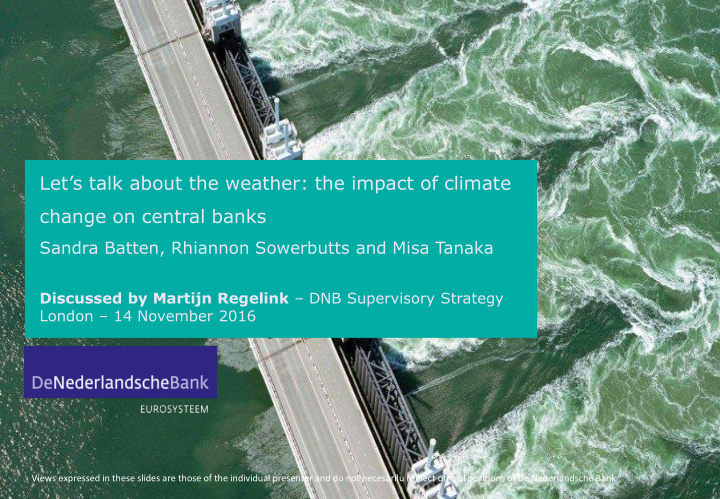



Let’s talk about the weather: the impact of climate change on central banks Sandra Batten, Rhiannon Sowerbutts and Misa Tanaka Discussed by Martijn Regelink – DNB Supervisory Strategy London – 14 November 2016 Views expressed in these slides are those of the individual presenter and do not necesarilu refilect official positions of De Nederlandsche Bank
Overview What is this paper about? Article examines the impact of climate change and related energy transition Objective effects on financial stability and monetary objectives of central banks Buildig on earlier work of BoE, paper derives number of channels by which climate change affects central banks. Most importantly: o Physical risks that have the pottential to trigger financial and macro economic instability o Transition risks which arise from unexpected tightening of carbon Main points emissions Article provides options for sector and regulators on how to deal with these risks. o Disclosure o Stresstesting 2
Overview What is the strength of this paper? Paper is consistent with work from a.o.: Multilateral innitiatives, such as FSB TCFD, G20 Green Relevance Finance Study Group Central Banks Financial sector Paper provides easy accasible overview of the topic, Overarching view and including relevant literature focus on interlinkages Interlinkages between banks and insturers are explored Exploration of benefits and limits of regulatory and policy Discussion on policy options, particularly stress testing and disclosure options 3
Comments structure From a conceptual point of view this paper might benefit from a division between risk drivers and financial risks Framework paper Alternative framework Financial risk Legal / Business Credit Market liability Physical Risk drivers Physical Transition Transition Liability Source: G20 GFSG Synthesis report 4
Comments physical risk Article could pay more attention to physical market risks run by investors Market risks is mentioned (fig 2) But lacks elaboration Financial risk Climate linked natural Legal / disaster Business Credit Market liability Risk drivers Physical Increased uncertainty for investors Transition Asset fire sales Source: G20 GFSG Synthesis report 5
Comments transition risks The authors could explore the transition channel on financial stability further (1/2) Authors miss out on how different asset classes and different type of institutions are differently affected by an energy transition. 6% 37,8 bln € 9% 5% 23% 68% Percentage of total assets 4% Other Commodities 3% Stocks < 1 Year 1 < 5 Year Securities 39,7 bln € 2% Loans 9,3 bln € 1% 0% Banks Insurance companies Pensionfunds Source: Schotten et al. (2016) 6
Comments transition risks The authors could explore the transition channel on financial stability further (2/2) Paper focusses on impact of energy transition on the energy sector, while effects are most likely broader Banks Fossiel € 39,7 bln Fossil fuels 2,0% € 11,7 bln Power generation 1953 mld € Materials industry € 24,2 bln € 48,6 bln Transport CO 2 - intensief 7,7% € 66,4 bln Agriculture Insurers € 9,3 bln Fossil fuels Fossiel 1,2% Power generation € 10,9 bln € 5,5 bln Materials industry 794 mld € CO 2 -intensief € 2,7 bln Transport 3,2% € 5,9 bln Agriculture Pension funds € 37,8 bln Fossil fuels Fossiel 5,4% Power generation € 16 bln 699 mld € Materials industry € 13,5 bln € 6,9 bln Transport CO 2 -intensief € 12,4 bln 7,0% Agriculture 0% 1% 2% 3% 4% 5% 6% Exposure (in % and bln € ) 7 Loans Bonds Equity Commodities Alternative
Comments on tools and measures for mitigating risks Considerations on disclosure, stress testing and prudential measures Stress testing Authors raise lack of sufficient data on relevant exposures (bonds, credit) & data Our experience is that it is possible to gain more insights into these exposures Are there negative sides to more disclosure on this topic? Disclosure Section 2.1.1. discusses the effects of prudential policies as a way to mitigate Prudential climate change. policies Wouldn’t that fit better together with the discussions on stress testing and disclosure as a way to mittigate transition risk? 8
Recommend
More recommend